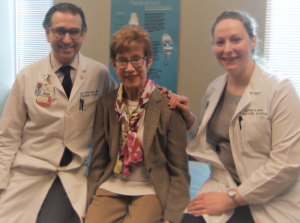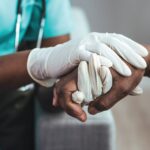I reluctantly and fearfully agreed to go. When the day of surgery arrived, Dr. Romond cleared his patient schedule and was granted permission to observe my hip revision surgery at the University of
Wisconsin. What a comfort to know my local orthopedic surgeon was there in the operating room, too.
In 2007, when my left hip revision was done, Dr. Romond again traveled to UW-Madison and also observed that surgery.
John Heiner, MD, is a specialist in orthopedic oncology and adult reconstructive orthopedics at UW Health in Madison. Initially, I was afraid to see him, but my fears were totally unfounded. Dr. Heiner’s ability to relate as “just a regular guy” and intersperse wit and humor in his interaction with patients is a true gift.
After my second hip revision in 2007, I asked Dr. Heiner if my new revisions would last until I died.
With a gleam in his eye, he quickly replied, “If you tell me when you’re going to die, I’ll tell you if they will last!”

Jorge Casas-Ganem, MD, Sarah Troxell and Jennifer Reed, PA.

Sarah Troxell and her granddaughter, Kate Laster.

Sarah Troxell, her son, John, and husband, Gary.
My left hip revision lasted eight years, but then developed an infection, which had to be dealt with. For almost two years, from 2015–17, I had a draining wound in my left upper thigh. It was biopsied, incised and drained, packed, and again incised and drained, with only brief periods of closure. I was also seen at a wound clinic, where treatment continued without success. Finally, a sinogram and computed tomography scan revealed two abscess cavities, connected by a sinus tract, inferior and medial to the inside angle of my left hip prosthesis. A second cavity was located above and lateral to the acetabular component of my prosthesis.
I was now living in Texas, so I could not return to Wisconsin to have Dr. Heiner treat this infection. Instead, I was referred to Jorge Casas-Ganem, MD, of Dallas, an orthopedic surgeon who treats joint infections and performs revision surgery. When local doctors are uncomfortable treating a complicated patient, Dr. Casas is their choice. Certainly, I am known as a complicated patient.
On Oct. 10, 2017, Dr. Casas performed surgery on my left hip prosthesis and replaced the titanium cup, the polyethylene liner and the titanium femoral head. The femoral rod remained. Coagulase negative Staphylococcus epidermidis was identified in the cultures taken from the prosthetic components, and I was given appropriate intravenous antibiotic treatment as an inpatient, which continued as an outpatient.

